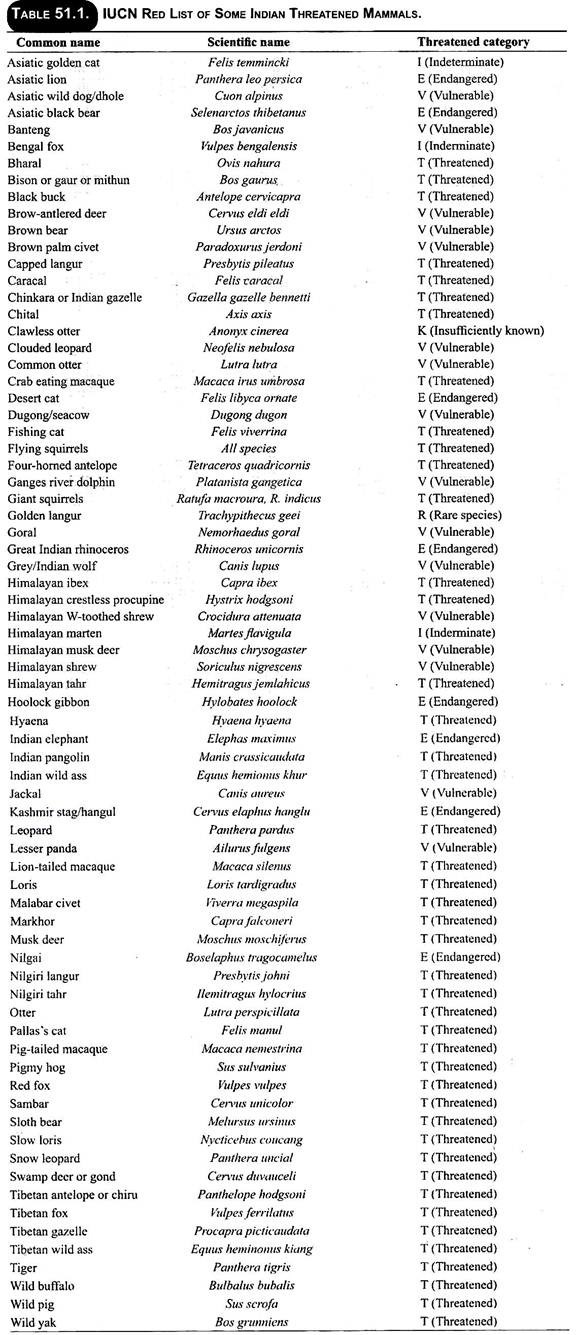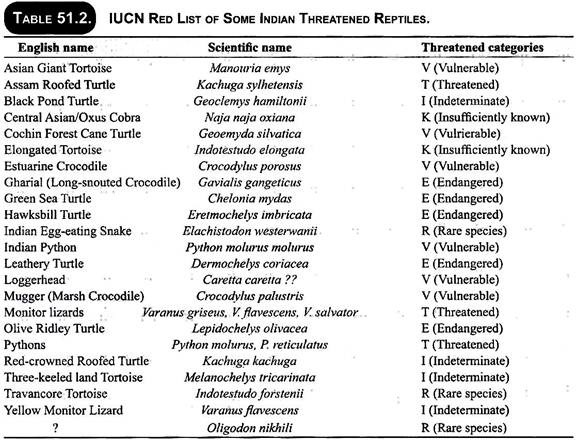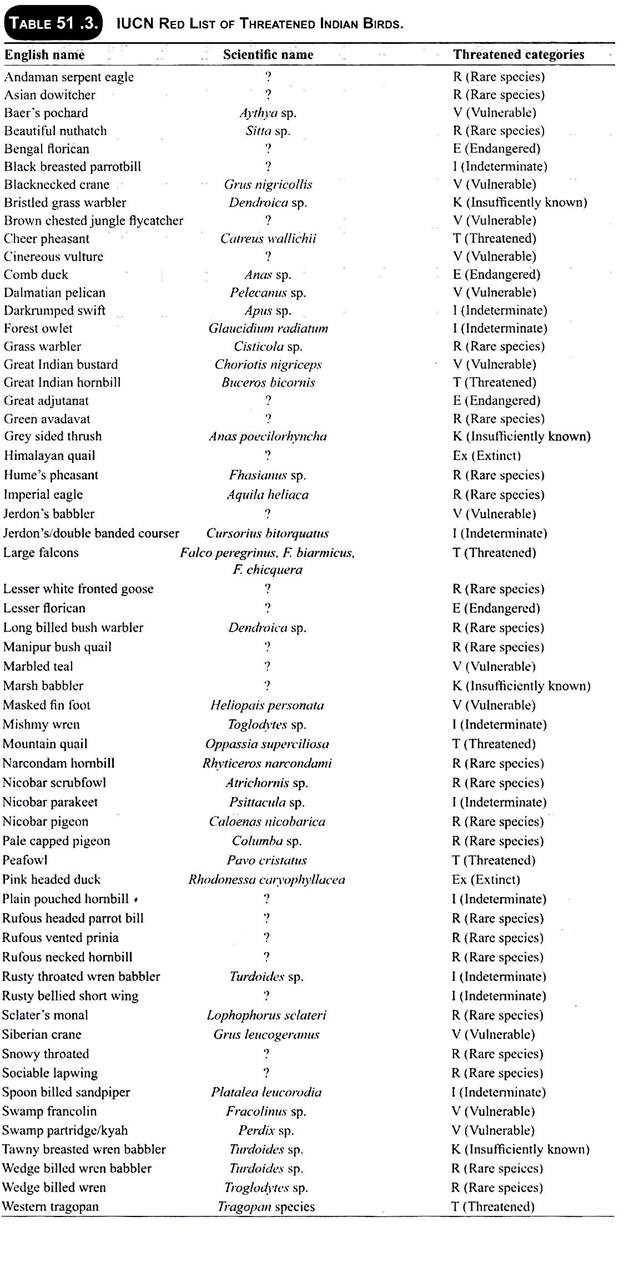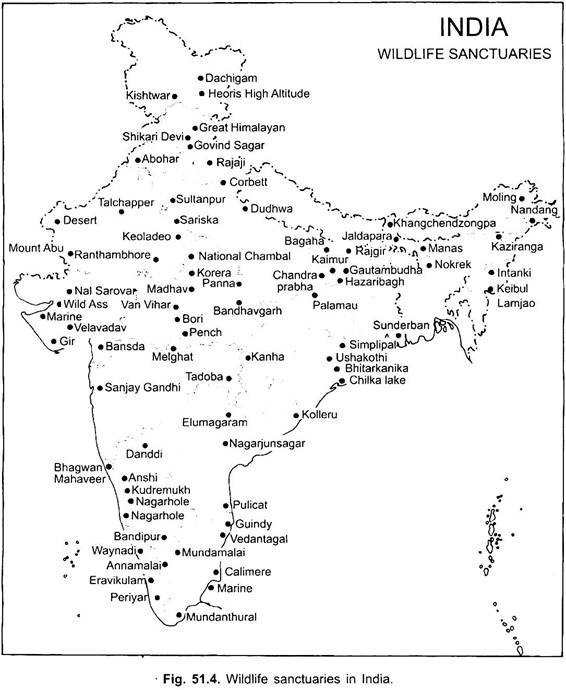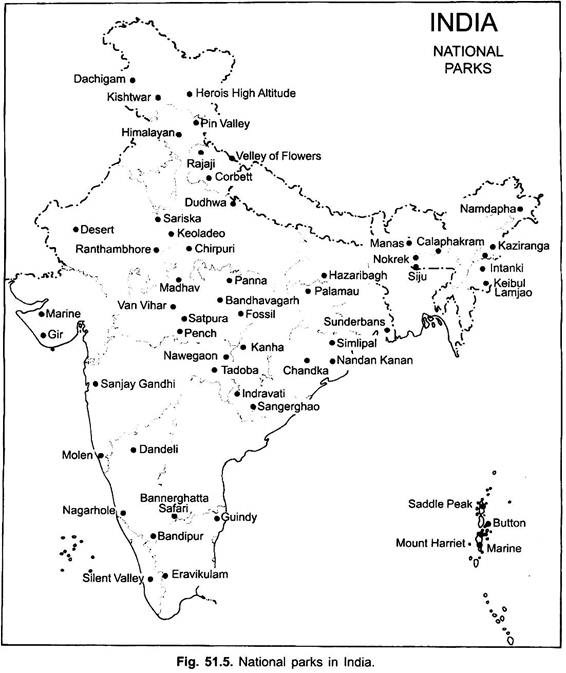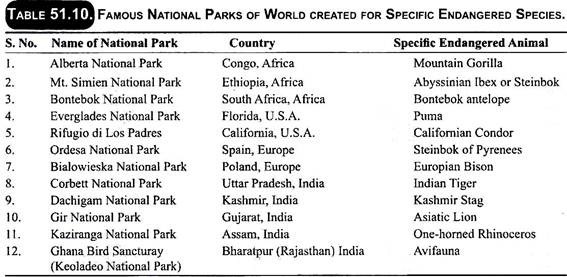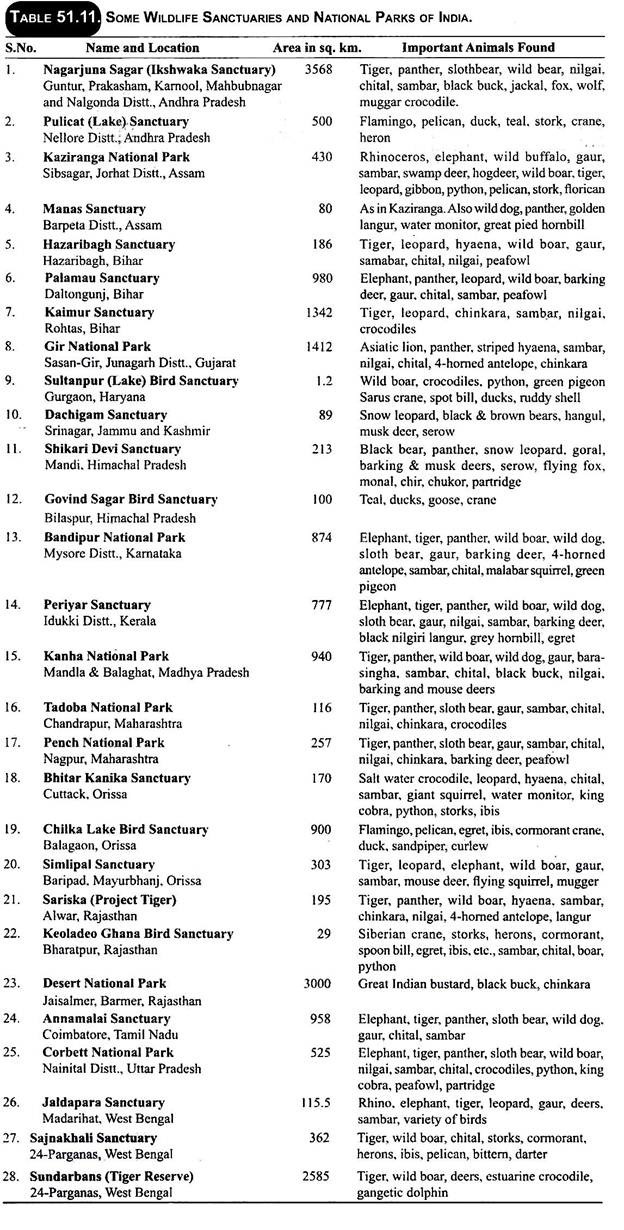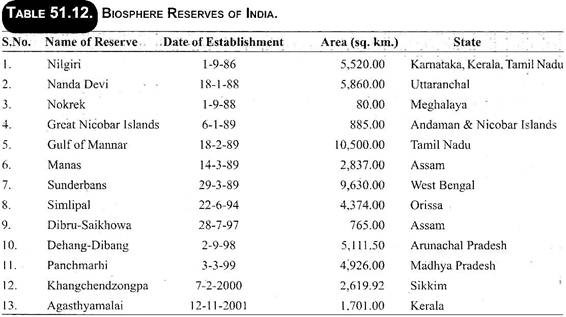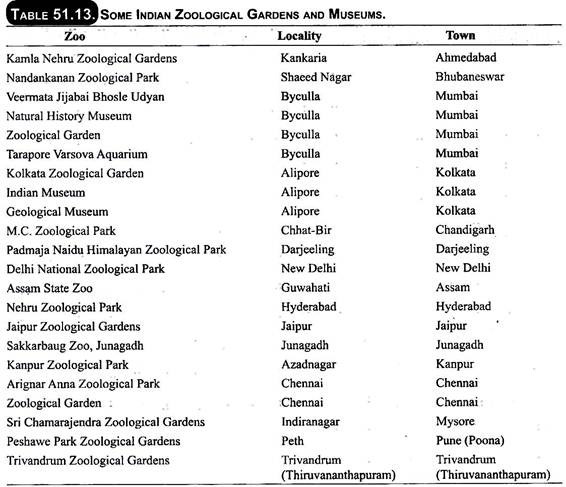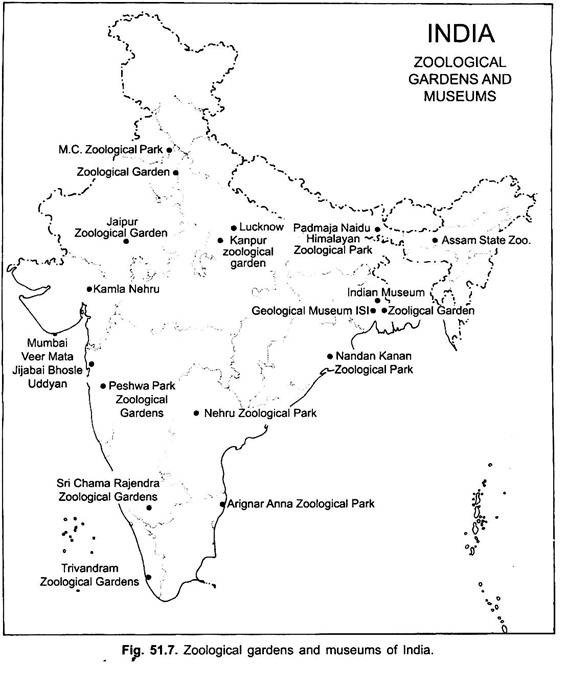Here is a compilation of essays on ‘Wildlife in India’ for class 11 and 12. Find paragraphs, long and short essays on ‘Wildlife in India’ especially written for school and college students.
Essay on Wildlife in India
Essay Contents:
- Essay on the Introduction to Wildlife
- Essay on the Importance of Wildlife
- Essay on the Conservation, Preservation, Protection and Categories of Wild Animals
- Essay on the IUCN Red List Categories
- Essay on the Protected Indian Wildlife
- Essay on the Sanctuary and National Park
- Essay on Some National Parks of India
- Essay on the Biosphere Reserves
- Essay on the Zoological Gardens and Museums
- Essay on the Wildlife Institute of India (WII)
- Essay on the Wildlife Act
1. Essay on the Introduction to Wildlife:
ADVERTISEMENTS:
Wildlife comprises all living organisms (plants, animals, microorganisms) in their natural habitats which are neither cultivated/domesticated nor tamed. But in its strictest sense, it includes uncultivated mammals, birds, reptiles, amphibians and fishes, etc., which are generally hunted.
Wildlife includes “Animals like mammals, birds, reptiles, amphibians and fishes and their young’s and also eggs of birds and reptiles” (Wildlife (Protection) Act, 1972). It also includes habitat like land, water or vegetation which is the natural home of any wild animal.
India has a rich heritage of wildlife. In India wildlife has a long history and tradition of conservation. The conservation ethic was observed in Ashrams of our sages which were the seats of learning in the country’s ancient past.
The Vedas include hymns in praise of animals and the Indian Mythology is full of references to several animal-like Gods such as the monkey-headed Hanuman, elephant-headed Ganesh, boar-headed Varahavatar, lion-headed Narasinghavatar, turtle-like Koormavtar, fish-like Matsyavatar, snake-like Shesh Nag, etc. We also learn about snake worship (Nag pooja), eagle worship (Garud pooja), cow-worship (Gau pooja), and vehicle of Lord Shiva (Bull Nandi), vehicle of Saraswati (Swan), vehicle of Lord Ganesh (rat), etc.
ADVERTISEMENTS:
King Pandu in Mahabharata was cursed by the hind deer for shooting her stag in mating. Rama was helped by Hanuman against Ravana, the flying deer hunted by Kalidas to the safety of rishi’s ashram, eight celestial points of compass being supposed to be guarded by Indira’s elephant, lion is one of the many incarnations of God Vishnu, the mongoose noticed in the Mahabharata as a teacher of wisdom of King Yudhishthira, the deer is always associated with God Brahma and the constant companion of Lord Mahadeva, the wild boar is referred to as the “Boar of Heaven”. About thirty different mammals are mentioned by name in the Samhitas (four principal Vedas).
The first recorded game laws were promulgated by Kautilya in his Arthashastra in the third century B.C. He proclaimed severe punishment for killing, entrapping animals in protected areas (sanctuaries). The Great Ashoka enacted laws for the protection of animals in his kingdom in third century B.C. Even in Christianity, Francis of Assisi loved and spoke to protect wild animals.
The condition of our wildlife deteriorated in the Moghul rule and later in British rule when slaughter of animals became the fashion of the day. Babar and Temur killed thousands of rhinoceroses in Kashmir and Northern India. Colonel Pollock, military engineer of British East India Company in Assam, shot a rhinoceros or buffalo almost daily for breakfast. Former Kings and Nawabs of various states of India were also very fond of hunting tigers.
Some wild animals are so characteristic that they become symbols of their home countries. Thus, tiger is associated with India, white bear with Russia, Giant Panda with China, Kangaroo with Australia, Kiwi with New Zealand and Springbok with South Africa.
ADVERTISEMENTS:
ADVERTISEMENTS:
2. Essay on the Importance of Wildlife:
Wildlife is important for the human beings, animals and plants. These are so closely interlinked that disturbance in one produces imbalance in the others.
1. Ecological Balance:
Wildlife maintains balance of nature through regulation of population of different species by self-regulation and feedback, passage of food and energy through series of different populations (food chain/food web), circulation of inorganic nutrients between abiotic and biotic environments, and prevention of leaching and runoff by plants. Terrestrial and aquatic animals play their role in the maintenance of balance of nature. Thus, it preserves the environment as a self-sustaining system. It balances populations and maintains food-chain and natural cycles.
2. Gene Bank:
Wildlife serves as a gene bank for breeding improved varieties in agriculture, animal husbandry and fishery. Plant breeders have been able to produce high-yielding and disease- and stress-resistant varieties from wild relatives of crop plants which possess useful genes for the purpose of breeding. Scientists have been constantly examining the wild relatives of crop plants for the presence of useful genes that can be introduced to breeding programmes. Hence, gene bank maintenance is essential. Some old rice varieties from Kerala saved rice cultivation when brown plant hopper (Nila-parvata lugens) attacked all modern rice varieties.
The production of high-yielding, disease-resistant crops, livestock and fish cannot continue without the wild relatives of the cultivated varieties. This is because of pests and pathogens evolve new strains; climate change; soils vary; and consumers’ demands change with time. Man is aware that the rich diversity of organisms today is the product of natural evolution occurring through 3.5 billion years. A species once lost cannot be retrieved. Therefore, it would be unethical to be responsible for the destruction of a species.
3. Plant Propagation:
Insects and birds, etc., are useful in pollinating certain plants which is very essential in plant propagation. Cross pollination increases the diversity of genetic recombination and viability of the plant vegetation.
ADVERTISEMENTS:
4. Cleaning of Environment:
Cleaning of environment and keeping it in hygienic state is carried by scavengers like vultures, eagles, jackals, hyaenas, etc. Microorganisms feed upon dead animals, convert them into different nutrients and, thus, release energy back to the soil making it fertile.
5. Soil Erosion:
Soil erosion is prevented by plant cover, litter, mixing of litter by movement of wild animals. Microorganisms convert litter into spongy humus.
6. Scientific Importance:
Scientific studies of many of wildlife species are of direct value to humans. These studies and researches in anatomy, physiology, ecology, evolutionary aspects, etc., are of direct value in saving human life. Sea urchins have helped greatly in the understanding of human embryology. A desert toad has helped in early determination of pregnancy. Rhesus monkeys have contributed a lot to the present knowledge of human blood groups.
Antlers of deer are useful in determining the degree of radioactive contamination of natural environment. Armadillos contributed to the development of vaccine for leprosy. We do not know when some obscure wild animal species may be put to prominence by providing a clue to human health and survival. When any drug of any disease is invented, research of its effects and side effects are carried on wild animals before applying on human body.
Rh factor in human blood was found due to Rhesus monkey. Chimpanzee helped us in conducting serological protein tests. Studies on animal behaviour helped the psychiatrist to read the human mind. Some wild flora and fauna have medicinal values. Muskpod of musk deer and rhinoceros’ horn are of great medicinal value. Fat of tiger or hornbill is used for curing rheumatism. Snake venom is used for preparing antivenom for snake bite.
7. Economic Importance:
Wildlife forms an important natural resource. Various useful products are obtained from plants such as timber, firewood, paper, gum, resins, tannins, several drugs, essential oils, spices, lac, silk, honey, hair, feathers, guano (the faecal matter of sea-fishes used as manure or the manure made from fish), leather, musk, ivory, etc., are obtained from wildlife. Besides these, benefits such as tendu leaf, cork, rudraksha, etc., are also obtained from wildlife.
Tribals living in forests also get food (tubers, roots, leaves and fruits of plants and meat from animals), medicines and other commercial products. The commercial value of wildlife is best seen in the world’s marine fisheries with an annual output of about 100 million tons of sea food worth billions of rupees. Freshwater fish and other aquatic creatures also provide large amount of food for people. Fish are as big as any other modern industry in respect of employment and income.
An entire industry for fur trade is supported by fur-bearing animals. Trade in live and dead animals, though illegal and banned throughout the world, supports thousands of people and also earns foreign exchange. For example, an Indian rhinoceros may fetch equivalent of Rs.1, 25,000 in the world market. Similarly, the ivory of elephants, the horns of rhinoceros, the glands of musk deer, the antlers of deer, etc., all provide high prices. Wildlife of a country may even attract people from abroad and earn foreign exchange. Wildlife tourism can be made a big source of income.
Thus, it is important to develop more biological reserves, parks, safaris and zoos for tourism from economical point of view. The tourist industry of Kenya (East Africa), based on its wildlife, ranks third after coffee and sisal.
8. Potential Importance:
Just as all present-day cultivated/domesticated plants and animals are derived from wildlife; new foods, beverages such as tea, coffee, cocoa, etc., drugs and other useful products may be obtained from wildlife.
9. Game Importance:
Wildlife has its importance in game also. In several European and American countries, millions of people hunt or fish for recreation, spending billions of dollars on these sports.
10. Aesthetic Importance:
There is a great aestheic value of wildlife throughout the world because of sheer beauty, tranquillity and appeal to the humans. A world without colourful and melodious birds, graceful beasts and deep forests would be a poorer place for humans to live. Without wild animals, a countryside would be static and monotonous. People feel pleasure, satisfaction and happiness in the presence of wildlife. Pandit Jawaharlal Nehru said, “Life would become very dull and colourless if we did not have these magnificent animals and birds to look at and to play with.” Smt. Indira Gandhi also said, “A threat to any species of plant and animal life is a threat to man himself.”
11. Ethical Importance:
Generally civilised people think that they have no right to destroy wildlife (plants and animals), rather they feel an obligation for the conservation of nature and protection of wildlife. In fact, all religions preach respect and reverence for life and consider it wrong and unethical to take the life of an animal.
3. Essay on the Conservation, Preservation, Protection and Categories of Wild Animals:
1. Conservation:
“Conservation means the maintenance of a reasonable number of members of every species from the largest mammals to the smallest invertebrates in their own habitat without destroying that habitat” -Noel Simon.
According to Indian Forest Record (1965), conservation means, planned management and wide use of natural resources, so as to prevent over-exploitation, destruction or neglect, i.e., wildlife conservation.
2. Preservation:
Preservation is the protection of a species without regard to the consequences. Preservation is to save and maintain the wild animals against injury or destruction as well as keeping them safe and undisturbed from private or public use.
3. Protection:
Guarding the wild species against danger or injury is protection. Partial protection of certain species is to enforce closing of hunting, fishing, etc., and restricted shooting. Total protection is achieved by forming sanctuaries or by legally prohibiting the killing or minimising of a particular species in any place.
4. Extinction of a Species:
Extinction of a species is a part of a natural process. Extinction is “biological reality” because no species has as yet existed for more than a few million years without evolving into something different or dying out completely. But with the gradual emergence of human beings being a major evolutionary force, people have been increasingly exploiting the wildlife.
As many as 500 million kinds of plants, animals, and microorganisms have made this planet as their home since life began over 3.5 billion years ago. Today, there are more than 30 million species alive. The rate of decline has been rapid in the last one hundred years. It is estimated that about 25,000 plant species and 1000 vertebrate species and subspecies are threatened with extinction. Several invertebrates are also invariably vulnerable. At least about 10% of the living species are supposed to be in danger.
5. Extinct Species:
Extinct species are those which were found in the past but became disappeared and not found now. They are no longer known to exist in wild, though it may survive in cultivation. According to CITES, a species is said to be extinct, if it is not definitely known in the wild during the past 50 years.
Extinction results ecological hazards, imbalances in ecosystem and food chain/food-web, ultimately affecting present and future generations of human beings. For example, extinction of cheetah, two-horned rhinoceros, mountain quail, Pin-headed duck from India and Dodo bird from Mauritius, etc.
Causes of Extinction:
Causes of extinction are as follows:
(i) Hunting:
Hunting is large-scale destruction of wildlife for food, safety and pleasure. It was started with the use of fire as a means of hunting. Man-made forest fires have caused the extinction of several species in the past. Hunting as a sport and needless killing of wild animals is dangerous. Disappearance of dodo (Didus ineptus) of Mauritius and cheetah (Acinonyx jubatus) from India are recent calamities. A number of orchids and medicinal plants have also disappeared.
(ii) Destruction of Habitats:
Destruction of habitats of wildlife is also a threat to them. It has been destroyed due to establishment of new human settlements, croplands, grazing grounds, quarry in mining sites, etc. Deforestation caused by jhuming, cutting of trees for timber and overgrazing, conversion of forest into agricultural land, building of roads and rails, construction of dams/reservoirs, etc. Damage to the forest and grasslands are caused by acid rain. Hence, the most serious depletion of wildlife comes from habitat destruction.
6. Endemic Species:
Endemic species is that which is found in a particular natural habitat beyond which it is unknown. The plant and animal species confined to a given region and having originated there are called endemic species. India has a large number of endemic species like Ficus religiosa, Butea monosperma, etc.
4. Essay on the IUCN Red List Categories:
The World Conservation Union (WCU), formerly known as International Union for the Conservation of Nature and Natural Resources (IUCN), has recognised eight Red List Categories of species.
These are as follows:
1. Extinct (Ex)- A taxon is Extinct where there is no reasonable doubt that the last individual has died.
2. Extinct in the Wild (EW)- A taxon is Extinct in the Wild when exhaustive surveys, in known and/or expected habitats, have failed to record an individual.
3. Critically Endangered (CE)- A taxon is Critically Endangered when it is facing an extremely high risk of extinction in wild in the immediate future.
4. Endangered (E)- A taxon is Endangered when it is not critically Endangered, but is facing a high risk of extinction in the wild in the near future.
5. Vulnerable (V)- A taxon is Vulnerable when it is not Critically Endangered or Endangered, but is facing a high risk of extinction in the wild in the medium-term future.
6. Lower Risk (LR)- A taxon is Lower Risk when it has been evaluated and does not satisfy the criteria for Critically Endangered, Endangered or Vulnerable.
7. Data Deficient (DD)- A taxon is Data Deficient when there is inadequate information to make a direct, or indirect, assessment of its risk of extinction.
8. Not Evaluated (NE)- A taxon is Not Evaluated when it has not yet been assessed against the above criteria.
The IUCN Red List is a catalogue of those taxa which are facing the risk of extinction.
The species which are threatened with extinction are included in Vulnerable, Endangered or Critically Endangered categories:
Rare Species (R):
Taxa with small world population that are not at present “Endangered” or “Vulnerable” but are at risk.
In practice, ‘Endangered’ and ‘Vulnerable’ categories may include, temporarily, taxa whose populations are beginning to recover as a result of remedial action, but whose recovery is insufficient to justify that transfer to another category. These taxa are usually localised within restricted geographical areas or habitats or are thinly scattered over a more extensive range.
Indeterminate (I):
Taxa known to be ‘Endangered’, ‘Vulnerable’ or ‘Rare’, but where there is not enough information to say which of the three categories is appropriate.
The IUCN Red List System was initiated in 1963, and since then evaluation of the conservation status of species and subspecies is continuing on a global scale.
The 2000 IUCN Red List contains assessments of more than 18,000 species, of which 11,000 are threatened.
Status of Threatened Species:
According to 2000 IUCN Red List, there are 11,046 species listed as threatened, i.e., Critically Endangered, Endangered or Vulnerable. Of these 5,485 are animals and 5,611 are plants. 1,939 species are listed as Critically Endangered, of which 925 are animals and 1,014 are plants.
5. Essay on the Protected Indian Wildlife:
There is a great deal of protected Indian wildlife. Tables 51.1, 51.2 and 51.3 provide a list of some common Indian mammals, birds and reptiles which are threatened or endangered with extinction. They have been declared as protected species so that their hunting (capturing, poisoning, injuring, killing, etc.) is illegal under the provisions of the Wildlife (Protection) Act, 1972.
Indian Threatened Mammals:
There are nearly 372 species of mammals found in India including various species listed in threatened categories (IUCN Red List of Threatened Animals Table 51.1).
This database provides information on the distribution of mammalian species in various protected areas of India:
Indian Threatened Reptiles:
There are 447 species of reptiles found in India including a number of species listed in threatened categories (Table 51.2). This database provides information on the distribution of reptiles in Indian protected areas. Large number of information related to species distribution on various protected areas has been linked with various protected areas including tiger reserves.
Indian Threatened Birds:
According to IUCN, there are 1,228 species of birds found in India including 65 species listed in various threatened categories (Table 51.3). This database provides information on the distribution of birds in various protected areas of India.
Large number of information related to species distribution on various protected areas have been collected and documented in the form of check lists are given below:
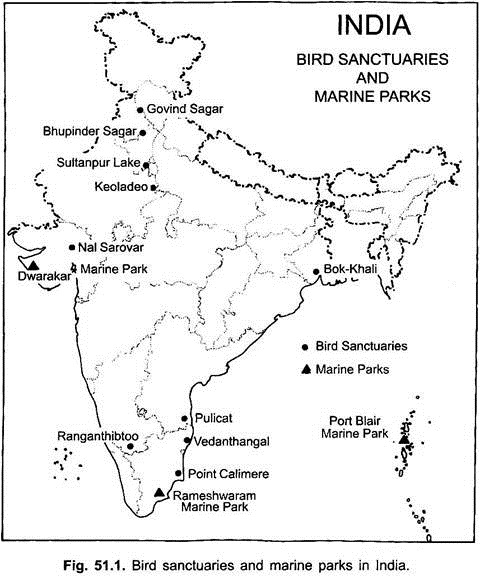
6. Essay on the Sanctuary and National Park:
Sanctuaries and national parks are the final refuge of wildlife and constitute an insurance against the total disappearance of species.
Sanctuary:
“It is an area where killing and capturing of any species of birds or animals is prohibited except under orders of competent authority and whole boundaries and characters should be sacrosanct (free from outrage) as for as possible”.
The IBWL (Indian Board for Wildlife) has further clarified the position by stating that while the management of sanctuaries does not involve suspension or restriction of normal forest operations, it is desirable to set aside a completely sacrosanct area within a sanctuary to be known as ‘Abhayaranya’. It is also indicated that sanctuaries should be made accessible to the public. In these “Ashrams” of wildlife, destruction of the wild animals is prohibited by law. These areas will be from nurseries of wild animals to replenish areas with depleted stock from time to time.
According to Wildlife (Protection) Act, 1972, Section 18, “The State Government may by notification declare any area to be a sanctuary if it considers that such area is of adequate ecological, faunal, floral, geomorphological, natural or zoological significance, for the purpose of protecting, propagating or developing wildlife, or its environment.”
No person is allowed to move freely inside the sanctuary without the permission of the authority. Inside the sanctuaries, carrying of weapons without permission, setting fire or candle any fire or leave any fire burning, use of explosives and chemicals are strictly prohibited. The competent authority can take proper steps from management point of view for the security of wild animals and may regulate, control or prohibit grazing or movement of cattle or fishing in the interest of wild animals.
National Park:
“A national park is a relatively extensive area- (1) in which one or more ecosystems have not been physically altered by human exploitation and occupation, where plant and animal species, geomorphological sites and habitats are of special scientific, educational and recreational interest, or where the natural scenery is of great beauty; (2) or eliminate exploitation or occupation of entire area in the briefest possible time and to effectively complete respect for the ecologic, geomorphologic or aesthetic features which lead to its establishment; (3) where visitors are allowed and special condition for inspirational, educational, cultural and recreational purposes” (IUCN).
“An area dedicated by statute for all time to conserve scenery, natural and historical objects of national significance and wildlife, and where provision is made for the enjoyment of the same by the public” (IBWL).
According to Wildlife (Protection) Act, 1972, Section 35, “Whenever it appears to the State Government that an area, whether within a sanctuary or not, is by the reason or its ecological, faunal, floral, geomorphological or zoological association or importance, needed to be constituted as national park for the purpose of propagating or developing wildlife therein or its environment it may, by notification, declare its intention to constitute such area as National Park.”
From the definition, the difference between sanctuary and national park shows that sanctuary should be natural or of zoological significance, whereas a national park should be of zoological association or importance.
Indian Sanctuaries:
There are 493 existing wildlife sanctuaries in India, covering an area of 117,291.03 sq. km., which is 3.57% of the geographical area of the country. Another 217 sanctuaries are proposed in the Protected Area Network Report covering an area of 16,669.44 sq. km. Maximum number of sanctuaries exist in size class less than 10 sq. km., and there are only 2 sanctuaries, having more than 5,000 sq. km. The network of sanctuaries will go up 709 after full implementation of the above report (Table 51.8 and Figure 51.4).
National Parks:
There are 89 existing National Parks in India covering an area of 37,526.90 sq. km., which is about 1.14% of the geographical area of the country (National Wildlife Database, 2003). In addition to the above, 74 National Parks covering an area of 16,630.08 sq. km., are proposed in the Protected Area Network Report. The network of parks will go up to 164 after full implementation of the above report. Maximum number of parks exist in size about 100-500 sq. km., and there are 7 parks having more than 5,000 sq. km. (Table 51.9 and Figure 51.5).
7. Essay on Some National Parks of India:
1. Corbett National Park (Project Tiger):
Total area: 520.80 sq. km.
Year of establishment: 1936
Location: Himalayan foothills in Nainital and Garhwal districts, Uttaranchal.
Climate: Annual temperature varies between 4°C and 46°C.
This is the first National Park of this subcontinent whose first name was Hailey National Park in the name of the then U.P. Governor, Mr. Malcom Hailey. After independence, it was named as Ram Ganga National Park in the name of Ram Ganga River. Further, to honour Jim Corbett (famous hunter and naturalist) its name was changed as Corbett National Park in 1956. In 1973, National Park was declared as Tiger Reserve to give special protection to the tigers of this part.
Fauna: Mammals: Herbivores:
Elephant, Sambhar, Nilgai, Goral, Cheetal, Para, Barking deer, Wild boar, etc.
Carnivores:
Tiger, Panther, Wild dog, Jackal, Red fox, Black bear, Sloth bear, Common otter, Indian civet, Palm civet, Mongoose, Long-eared hedgehog, Shrew, etc. Bats, Hare, Northern Palm Squirrel and Porcupine are also common.
Birds:
Peacock, Jungle fowl, Partridges, Water birds like Ducks, Falcons, Coots, Dab chicks, Naktas, Kingfishers, besides some carnivorous birds like Hawks, Vultures, etc. Many migratory birds also visit the Ram Ganga River during winter.
Reptiles:
Crocodile (Mugger) and Gharial, Common monitor lizard, some lesser lizards and soft shelled tortoises. Python, Cobra, Viper, Water-snake, Boa, Cat-snake and Wolf-snake, etc.
Tiger is our national animal and found in diverse habitats and in different parts of the country. Tiger is a top carnivore of the complex food chain in our forest ecosystems. From several years, over-exploitation of the forest areas, merciless hunting, unscientific management, etc., reduced the habitat of tiger that leads to a rapid decline in its population.
Thus, tiger conservation in India is very necessary to save this endangered species. IBWL set up a task force for studying the tiger population and its status. On recommendations of this task force, Project Tiger was initiated in 1973 with eleven Tiger Reserves located in ten different states.
2. Betla National Park (Tiger Reserve):
Total area: 1026 sq. km.
Climate: Summer maximum temperature 48°C and winter temperature 3°C.
It is located in the western part of Chotanagpur plateau in Jharkhand state. Tiger reserve was declared on 4th June 1974 and in 1986 it was declared as National Park. Tiger reserve comprises most of the forests of Daltonganj South Forest Division. These forests were very rich in wildlife such as Tigers, Leopards, Bear, Wolf, Jungle cat, Wild dog, Mongoose, Small civet, Palm civet, Jackal and Hyaena. In 1934, tiger population was 32 (one tiger per 9.3 sq. km.) and when it was declared as Tiger Reserve its population density was one tiger per 33 sq. km. Main river in this area is Koel which has its three tributaries, Auranga, Burha and Pandra.
Main rocks of this reserve are laterite, quartzite, gneiss, gondwana and amphibolites, etc.
3. Kanha National Park (Project Tiger):
Total area: 940 sq. km.
It is located in Sylvan Maikal Hills in Mandla and Balaghat districts on the Satpura ranges in Madhya Pradesh. Its name Kanha was given from the old Kanha village. Forest is rich in sal trees, bamboos, etc. Important wild animals are Tiger, Panther, Cheetal, Sambhar, Nilgai, Gaur (Indian bison), Langur (Presbytis entellus), Barasingha (Swamp deer) Cervus duvauceli branderi, Barking deer, Blackbuck, Wild pig, Wild dog, Jackal, etc. Swamp deer named “Branderi” was saved from extinction.
4. Sunderbans National Park (Tiger Reserve):
Total area : 2585 sq. km.
It is located in West Bengal. The mangrove forests occurring at the mouth of Ganga and Brahmaputra river system (river divides itself into hundreds of streams which join Bay of Bengal) is known as Sunderbans. Mangrove vegetation or “Mangals” have high degree tolerance for saline environment. They possess breathing-root, (pneumatophores), stilt-roots for support, salt excretory glands, vivipary, etc.
The mangrove fauna is supreme. Tiger, birds (Storks, Herons, Domestic ducks, etc.), reptiles (Olive Ridley Turtle and Estuarine Crocodile-both are endangered species), Fishes (Mud-skippers and Semi-terrestrial gobies both are independent of water) and crustaceans (Land crabs and Fibber crabs are most famous). Spotted deer, Pigs, Monitor lizards and Monkeys also inhabit the forest.
5. Gir National Park (Gir Lion Project):
Total area : 258.71 sq. km.
It is situated in Saurashtra peninsula of Junagarh district of Gujarat. It was declared as sanctuary in 1965 and the project was started in 1972. The fauna of this park is Asiatic lion (Panthera leo persica), Panther, Striped hyaena, Sambhar, Nilgai, Cheetal, Four-horned antelope, Chinkara, Wild boar and Crocodiles. Its habitat mainly includes dry teak forests and open scrub jungle.
Lion stands as top carnivore in the food chain of the ecosystem. It is found only in Gir Forest in the whole Asian Continent and, hence, called Asiatic lion. Even in this forest, due to merciless hunting, conversion of forest into agricultural land, uncontrolled cattle grazing and spreading infectious diseases, etc., reduced its habitat and subsequently declined population to the endangered state.
6. Bandipur National Park (Tiger Reserve):
Total area : 874.20 sq. km.
It is located in Mysore district (80 km from Mysore city) of Karnataka. Project Tiger Plan Scheme was initiated in 1973-74 in Bandipur National Park. Rivers of this area are Kabim, Nagu and Moyar. The reserve includes southern tropical moist deciduous and dry deciduous forests. Here teak trees are abundant and other trees are rosewood, sandalwood, laurel, yellow teak, kydia and bamboos.
The fauna of this reserve is Cheetal, Muntjac, Sambhar, Chausingha, Gaur, Wild boar, Elephant, Moue deer, Black-naped, Hare, Sloth bear, Langur, Bonnet macaque, Giant squirrel, Flying squirrel, Tiger, Leopard, Wild dog, Jungle cat, Small Indian civet, Toddy cat, Striped-neck and common mongoose, Crocodiles, Snakes and Monitor lizards. Avian fauna is Pied hornbill, Green pigeon, Woodpeckers, Drongoes, Bee-eaters, Kingfishers, Peafowl, Jungle fowl, Partridge and Quails.
7. Bannerghatta National Park:
Total area : 104.27 sq. km.
It is situated in Karnataka, just 22 km from Bangalore. It was created in 1974 to protect local fauna and flora. Area is covered by dry thorny scrub and dry deciduous scrub jungle. Lions and Tigers are found roaming free in an enclosed area of 15 ha. Visitors can move inside the Safari in a closed minibus of the park. Safari also have Gaur, Cheetal, Sambhar, Barking deer, poisonous and non-poisonous snakes, rare varieties of tortoises and lizards.
8. Kaziranga National Park:
Total area : 849.79 sq. km.
It is located in Sibsagar district of Assam. It is about 217 km from Guwahati. Its fauna is Great Indian One-horned Rhinoceros (Rhinoceros unicornis), Wild buffalo, Tiger, Leopard, Elephant, Gaur, Gat, Mongoose, Otter, Civet cat, Wild boar, Swamp deer, Hog deer, Sambhar, Langur, Python, Pelican, Partridge, Floricans, Hoolock and a number of migratory birds during winter. Painted storks, Adjutant stork, Sarus, Cranes, Darter, Brahminy duck and Bar-headed goose are also kept here in the small island surrounded by water and some shore land.
9. Keibul Lamjao National Park:
Total area : 40 sq. km.
It is situated at the south-eastern corner of Loghtak Lake in Manipur State. It was named earlier as Sanctuary in 1968 but in 1977 it was declared as a National Park. Its fauna is Brow- antlered deer or Thamin (Cervus eldi eldi) locally called “Sangai” (also called Dancing Deer), Hog deer, Wild goat, Water birds, etc.
10. Dachigam National Park (Project Hangul):
Total area : 141.00 sq. km.
It is situated in Jammu and Kashmir State. Hangul Project was taken up by IUCN/WWF in 1970. It was declared as National Park in 1981. Its main animal is Hangul (Kashmir Stag) (Cervus eiaphus hunglu), which is a large deer roaming singly or in herds of 2 to 18. It is also found in north of Chamba (Himachal Pradesh). Habitat of Dachigam includes scrubs and savannah forests. Along Hangul are also found Black bear, Brown bear, Leopard and Snow leopard, Musk deer, Serow and Pheasants, etc.
Famous National Parks of World:
The first national park in the world, the Yellowstone National Park, was founded in 1872 in U.S.A. Since then, about 2,000 parks have been established all over the world. These offer protection to thousands of endangered species in their natural habitats. Some parks have been created for specific and very rare endangered species to be saved from extinction.
Table 51.10 provides a list of some of such famous parks of the world:
8. Essay on the Biosphere Reserves:
The concept of Biosphere Reserves was evolved under UNESCO’s Man and Biosphere (MAB) Programme in 1971 with the following objectives:
1. To conserve, for present and future human use, the diversity and integrity of biotic communities of plants and animals within natural ecosystems, and to safeguard the genetic diversity of species on which their continuing evolution depends.
2. To provide areas for ecological and environmental research including, particularly baseline studies both within and adjacent to these reserves, such research to be consistent with objective (1) above.
3. To provide facilities for education and training.
4. To promote international cooperation.
The concept of Biosphere Reserves is of immense value to conserve the gene-pool resources of flora and fauna in the country and to serve as bench-marks for future studies. This requires a detailed survey and classification of natural ecosystems for proper identification of their biological diversity and pristine (ancient) attributes (consider as belonging).
The areas identified should be large enough to be viable. In view of the virtual disappearance of many genuinely natural ecosystems in the country, those that remain in such natural or near natural condition need to be identified with utmost urgency. The recent Silent Valley controversy highlights the urgency of the problem.
In a biosphere reserve, multiple land use is permitted by designating various zones. There is the Core Zone (where no human activity is permitted), the Buffer Zone (where limited human activity is allowed) and the Manipulation Zone (where a large number of human activities would go on). In a biosphere reserve, wild population as well as traditional lifestyles of tribals and varied domesticated plant and animal genetic resources is protected.
Biosphere Reserves are multipurpose protected areas which are meant for preserving genetic diversities in representative ecosystems by protecting wild populations, traditional lifestyle of tribals and domesticated plant/animal genetic resources. There are some 243 biosphere reserves in 65 countries of the world. In India 14 potential sites were identified in 1979 by Core Advisory Group but only 13 biosphere reserves have been set up by now.
Each biosphere reserve has a:
(a) Core Zone: No human activity is allowed.
(b) Buffer Zone: Limited human activity is permitted.
(c) Manipulation Zone: Human activity is allowed but ecology is not permitted to be disturbed.
(d) Restoration Zone: Degraded areas for restoration to near natural form.
India has identified 14 areas to be declared as Biosphere Reserves. Of these the first biosphere reserve, Nilgiri Biosphere Reserve having an area of 5520 sq. km., was established in 1986. The second biosphere reserve was established in 1988, Nanda Devi Biosphere Reserve. In this very year (1988) third biosphere reserve, Nokrek Biosphere Reserves was set up.
Till 2001 following biosphere reserves were established as shown in Table 51.12 and Figure 51.6:
9. Essay on the Zoological Gardens and Museums:
Several zoological gardens and museums were also established to conserve the species in their wild state, to provide scientific, educational and recreational opportunities and to earn revenue.
The zoological gardens are somewhat different from sanctuaries and wildlife national parks as the animals are kept in cages in zoological gardens for show. The animals, thus, do not get natural habitat in zoological gardens.
Some important zoological gardens and museums of India are shown in Table 51.13 and Figure 51.7.
1. Natural History Museum, Mumbai, has excellent collection of animals, particularly fishes and birds.
2. Tarapore Varsova Aquarium, Mumbai, attached to sea and has beautiful collection of marine fishes and crustaceans.
3. Indian Museum, Kolkata, is the biggest museum in India.
4. Zoological Garden, Kolkata, is famous for talking parrots. It has good species collection.
5. Zoological Garden, Delhi, Lucknow, Kanpur, have some rare species of animals.
6. Geological Museum, ISI, Kolkata, are famous for complete skeleton of Indian Dinosaurs.
7. Zoological Garden, Hyderabad, has a rich collection of lions, tigers, monkeys and crocodiles.
10. Essay on the Wildlife Institute of India (WII):
A separate Directorate of Wildlife Environmental Education and Research was established at the Forest Research Institute and Colleges, Dehradun, in the Fifth Plan. A post-graduate diploma course in Wildlife Management, of one academic year’s duration, for people with forestry qualifications has been started by the Directorate since 1977.
The Directorate has also sponsored fellowship grants for conducting research on wildlife topics in the universities. Research in field oriented management techniques is also being conducted at the Directorate. Proposals for strengthening the research base and organising short-term orientation course for decision makers, administrators and professional groups are being considered for the Sixth Plan.
To train people and expand the activities in wildlife, Government of India has established a Wildlife Institute of India (WII) at Dehradun. This institute is engaged in management and extension of wildlife. It runs several courses at post-graduate level along with diploma and other short-term courses in specialised fields. As a result of training by this institute a number of trained persons are now engaged in conservation and extension of wildlife in India.
11. Essay on the Wildlife Act:
Wild animals are the integral part of the ecosystem performing a vital role in maintaining food chain and food web. Thus, their existence and survival on the earth planet is so important and essential for the natural balance and also for the existence of human life.
India is an under developing country facing many problems like tremendous growth in human population, poverty, unemployment, illiteracy and unawareness towards wildlife and nature. As a result, there is lot of pressure on forest and wild animals. Encroachment of forest land converting it into agricultural field, illicit felling of trees, illegal hunting and poaching, smuggling and merciless killings of wild animals have resulted in dwindling population of wild animals and shrinkage of their habitats.
Several species have been brought to the endangered/threatened category, many are on the verge of extinction surpassing the stage of critical limit, and extinction of many important species has taken place. Therefore, the forest personnel as well as people should have holistic view and approach in forest activity whether it is tree and/or wild animal.
In the year 1800, for the first time in India, the exploitation of wildlife was started on scientific basis. In 1806, first Forest Conservator was appointed at Madras Presidency. In 1847, an eminent botanist was appointed as Forest Conservator at Bombay. In 1855, the administrative structure of Forest Department was framed. In 1864, Sir Brandis became the first Forest Inspector General. In 1887, first systematic law in India was enacted by the British called “Wild Birds’ Protection Act of 1887”.
But due to wanton killing of wild animals and birds, a comprehensive legislation was passed, i.e., “Wild Birds and Animals (Protection) Act, 1912”. Again in 1935, the Act was amended calling it “Wild Birds and Animals (Protection) Act, 1935”. All these laws were aimed at not hunting the game animals and trade in products derived from wild animals. Much attention was not taken in conserving and propagating the wild animals throughout the country.
Before independence, the protection of wildlife was the responsibility of native rulers and local forest officers under the Indian Forest Act, 1927. There was rapid depletion in the population of wild animals. British rulers realised the importance of conservation of wildlife and enforced various laws like Rhino Protection Act, Elephant Protection Act, Arms Act, etc., from time to time to save them.
During Second World War the wild animals were mercilessly hunted by the soldiers and army officers wherever they halted. Bombay Natural History Society (BNHS), a private agency, established in 1883 took the first step in formulating a comprehensive Act for Bombay in 1951 called Bombay Wild Animals and Wild Birds Protection Act, 1951. After independence, in 1952 an advisory board calling Central Board for Wildlife was set up, which was renamed as Indian Board for Wildlife (IBWL).
Later Wildlife (Protection) Act, 1972 was formulated to conserve and propagate the wild animals with the salient provisions of creating sanctuaries and national parks as well as penalties against illegal hunting, poaching and trading, etc. The Act provides legal protection to the wildlife and to the endangered species of fauna listed in different Schedules.
This Act has been amended in 1982, 1986, 1991 and 1993. Amendment in 1991 has imposed total ban on hunting, constituted Central Zoo Authority, recognition of zoos, emphasising protection of plants, etc., amendment of certain sections, omission of words such as Special Game, Big Game and Small Game from the Schedules, addition of one more Schedule VI enlisting certain plants.
Need of Wildlife Management/Conservation:
In ancient years, the wildlife in India were found sufficient; but due to enormous growth in human population, deforestation started for converting forest land into agricultural purposes and subsequently the habitat of wildlife started shrinking and their population depleted and still depleting. The period of Second World War was the most devastating period for wildlife as the wild animals were killed mercilessly wherever the militaries got shelter.
Following are the main reasons causing depletion in wildlife population:
(i) Conversion of forests into agricultural fields.
(ii) In ancient time, hunting was done rudely (wantonly), recklessly, mercilessly and unscientifically.
(iii) Creation of forest roads as well as allowing there the hunters with their vehicles.
(iv) Use of firearms in hunting and hunting were not done selflessly.
(v) Increase in livestock, grazing by them in forest areas resulting in loss of food and shelter of wild animals as well as infection of diseases.
(vi) Establishment of industries in forest areas, quarrying of mines, etc.
(vii) Pollution of environment, rivers, water reservoirs and ocean by insecticides, polluted gases and water from industries as byproducts.
(viii) Use of insecticides on the large scale in agricultural fields.
(ix) Misuse of licensed firearms.
(x) Lighting of fire by the local people inside the forest.
These factors not only depleted the number of wildlife but some became extinct, some are threatened and some are on the verge of extinction. Their number has come to such a stage that the benefit derived from them is negligible.
Problems of Wildlife Management in India:
Mitra (1980) pointed out that the management of wildlife in India is beset with several problems. The shrinkage and degradation of forest and non-forest wildlife habitats as well as serious decline in the status of wild animals; conservation efforts started gathering momentum in the country in the early 1970s. The National Wildlife Action Plan was drawn up against this background.
It is a document setting out an agenda of countrywide activities in the field of wildlife conservation, which was released by the late Prime Minister Indira Gandhi in November, 1983.
The Action Plan covers a period of 5 years and contains ten sections, each representing a major area of activity in the field of wildlife which are as follows:
1. Establishment of Representative Network of Protected Areas (PA = Sanctuary and National Park);
2. Management of Protected Areas and Habitat Restoration;
3. Wildlife Protection in Multiple-use Areas;
4. Rehabilitation of Endangered and Threatened Species;
5. Captive Breeding Programmes;
6. Wildlife Education and Interpretation;
7. Research and Monitoring;
8. Domestic Legislation and International Conventions;
9. National Conservation Strategy;
10. Collaboration with Voluntary Bodies.
The National Wildlife Action Plan has provided a vital framework for conservation and management of India’s diverse wildlife resources and a yardstick by which progress can be measured.
Methods of Wildlife Conservation:
In wildlife conservation, the objective is that the wildlife is to be conserved in such a way that it may remain in the nature in peak status.
The most commonly adopted methods for the conservation of wildlife, in brief, are as follows:
1. Habitat Management:
Habitat management includes ecological study of the habits and habitats of wildlife species, protection, preservation and improvement of habitats, census and statistical data regarding species to be conserved, etc.
2. Establishment of National Parks, Wildlife Reserves, and Wildlife Sanctuaries:
The establishment of national parks, wildlife reserves and wildlife sanctuaries and zoological gardens serves many purposes such as:
(i) To conserve the species in their wild state;
(ii) To provide scientific, educational and recreational opportunities; and
(iii) To earn revenue from tourists by attracting them.
3. Breeding in Captivity:
Tree species, such as ginko and metasequoia, have survived only in captivity. Tiger, White Tiger and Indian Lion today live in National Parks. Gorilla is protected in the National Park of Alberta. The European Bison, saved at the eleventh hour, survives in the National Park of Biolowieska in Poland. Similarly Pere David’s Deer, Whooping Crane, Hawaiian Goose, Parma Wallaby and Arabian Gazzelle, once threatened with extinction, are considered to be already ‘on the way back’ as a result of captive breeding.
4. Reintroduction of Species:
Several animal species which were almost extinct, such as Arabian Oryx, Vicuna of High Andes, Russian Antelope or Saiga, Trumpeter Swan, Black Buck, Flamingos, etc., were allowed to reproduce and flourish in suitable places similar to the original ones. Later these were reintroduced in several parks and sanctuaries and areas of their original natural habitats.
5. Mass Education:
For any conservation programme, there is a great need of education to the people to achieve their participation.
To achieve this objective, the methods adopted are as follows:
(i) Celebration of wildlife week every year;
(ii) Publicity through media and film shows;
(iii) Holding essay competitions, lectures, seminars, conducted tours, etc.;
(iv) Setting up nature clubs in educational institutions;
(v) Publication of wildlife books and journals, etc.;
(vi) Establishment of Natural History Museum, etc.
6. Promulgation of Laws:
All the countries have promulgated laws for the protection and conservation of wildlife. In India, Wildlife (Protection) Act, 1972, a comprehensive Central Government Legislation, was enacted in 1972. Killing, capturing and hunting of wildlife without prior permission from competent authority, and poaching have become punishable under Wildlife (Protection) Act, 1972. In 1976, 42nd amendment in the Indian Constitution, protection of wildlife has been included in Concurrent List. Further amendment in law is required for severe and deterrent punishment to poachers.
